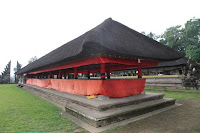This was followed again by the arrival of priest from Java, namely Hyang Tenuwuh live in the Mount Batukaru, Betara Manik Gumawang live in Ulun Danu Beratan, Betara Manik Galang in Pejeng, and Betara Hyang Tugu at Mount Andakasa.
Several centuries later Rsi Markandya imprisoned in Demalung area around Mount Dieng, East Java, and then be guided to meditate on the Mount Raung, East Java. There he was inspired to go to Bali. Accompanied by his followers (400 people) went to Bali directly to Mount Tohlangkir (Now Mount Agung), but, all of his followers dead to developing of the disease. He went back again to the Mount Raung, and imprisoned. In the monastery he received an instruction to return to the Mount Tohlangkir.
He was heading back to Bali to Tohlangkir with his 800 followers and buried pancadatu so that all of his followers could survived. Panca Datu is the five metals (gold, silver, bronze, copper, brass). Rsi Markandya then back to Tohlangkir. He buried the pancadatu in the village of Besukian (now Besakih). After performing this ritual, and built a temple in that place, he continued his westward to make a settlement.
In a jungle, at a glowing tree, he built a place for meditation called Pura Gunung Raung. He also opened settlement which is now called the village of Taro. He (rsi Markandeya) then spread his doctrine to the village.
From that point he then moved to the south part and built a meditation place, now named Pura Puncak Payogan. And, at a delta between Oos River and the Cerik River he built a meditation place again, named Pura Gunung Lebah. It said that the blend of those two rivers have a savor as a medicine. And therefore that area is now called as ubad (medicine in Balinesse language) which then change into the name of Ubud.
The name of Pura Gunung Lebah comes from the word of "mountain" and "lower". In the Balinese language, lebah means lower. The possibility of this name because the temple is situated at the top of a small hill located in a valley. The hill is the meeting point of two rivers namely Oos River and the Cerik River. This temple was built in the 8th century by the Rsi Markendya on his return from a trip to Mount Agung.
Pictures of Pura Besakih:



Pictures of Pura Gunung Raung:





Pictures of Pura Gunung Lebah, Ubud:







No comments:
Post a Comment